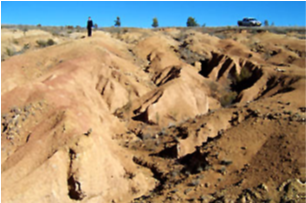Soil Resources
Land, Soil, Water, Natural Vegetation and Wildlife Resources of Class 8
Most part of the earth's surface is covered with soil. The thin layer of grainy substance covering the surface of the earth is called soil. It is closely linked to land. Landforms determine the type of soil. Soil is made up cf organic matter; minerals and weathered rocks found on the earth. This happens through the process of weathering. The right mix of minerals and organic matter make the soil fertile.

FORMATION OF SOIL
Soil formation is an extremely slow process. It takes hundreds of years to form one centimeter of soil layer. Soil formation is controlled by five factors.
- Nature of parent rock - Original rock from which the soil is formed determines its basic characteristics. Such as colour, texture, chemical properties, mineral content and permeability. For example, shale contributes clay, while sandstones contribute sand grains.
- The relief and topography - Altitude and slope determine the accumulation of soil. On a steep slope there is no accumulation of weathered rocks while in plains and areas with gentle slope, soils are accumulated without any hindrance.
- Climate - Temperature and rainfall influence, rate of weathering and formation of humus etc. For example frequent temperature changes and presence of water quicken the soil formation through increased weathering.
- Flora, Fauna and micro - organism in the soil - It affects the rate of humus formation. Dead plants and animals provide humus to the soil. Organisms like earthworm and ants through their movements create space for air and water in the soil.
- Time - It determines thickness of soil profile. Longer the time for soil formation, deeper is the soil layer.
DEGRADATION OF SOIL
- Soil looses its fertility if the land is not left fallow for sometime or the same crop is grown every year.
- Greatest loss to soils is caused by erosion which could be by wind or water. Loose soil devoid of vegetation is subject to higher rate of erosion.
- Physical factors responsible for soil erosion include slope, intensity of rainfall and velocity of wind.
- Human factors like overgrazing, deforestation, overuse by adding more and more chemical fertilizers, over irrigation leading to salination and poor agricultural practices have led to large scale destruction of soil.
REMEDY OF LAND DEGRADATION
- Planting of Shelter Belt of Plants
- Control of Overgrazing
- Stabilization of sand dunes by growing thorny bushes
- Control of Mining Activity
- Proper Discharge of Industrial Effluents & Waste
SOIL EROSION AND SOIL CONSERVATION
The denudation of the soil cover and subsequent washing down is described as soil erosion. The process of soil formation and erosion, go on simultaneously. Generally there is a balance between the two.
Causes of Soil Erosion
- Human activities like deforestation, over-grazing, construction and mining.
- Defective methods of farming.
- Ploughing in a wrong like up and down the slope forms channels makes way for quick flow of water. This leads to soil erosion. way etc. disturb this balance. Natural forces like wind, glacier and water lead to soil erosion.
- Sometimes water flows as a sheet over large areas down a slope. In such cases the top soil is washed away. This is known as sheet erosion.
- Wind blows loose soil off flat or sloping land known as wind erosion.
PREVENTIVE METHODS
- Contour Ploughing: Ploughing along the contour lines can decelerate the flow of water down the slopes.
- Terrace Farming: Steps can be cut out on the slopes making terraces to restrict erosion. Western and central Himalayas have well developed terrace farming.
- Strip Cropping: Large fields can be divided into strips. Strips of grass are left to grow between the crops. This breaks up the force of the wind.
- Shelter Belts: Planting lines of trees to create shelter also works in a similar way. Rows of such These shelter belts have contributed significantly to the stabilization of sand dunes and in stabilizing the desert in western India.
SOIL CONSERVATION
Protecting soil from being eroded is called soil conservation. The following steps can be taken to prevent soil erosion.
- Afforestation - Planting of trees is called Afforestation which prevents soil erosion, as their roots bind the soil.
- In hilly and mountainous areas -
- Soil can be conserved by controlling shifting agriculture and deforestation.
- Terrace farming i.e. growing of crops on level steps constructed on hill side.
- Contour ploughing which means ploughing parallel to the contours of a hill slope can reduce soil erosion.
- Contour barriers: Stones, grass, soil are used to build barriers along contours. Trenches are made in front of the barriers to collect water.
- Rock dam: Rocks are piled up to slow down the flow of water. This prevents gullies and further soil loss.
- In plains -
- Strip cropping which includes growing of different crops on parallel narrow strips of ground is useful in checking soil erosion.
- The binding of fields can reduce gully erosion in the areas of clayey soils.
- Mulching: The bare ground between plants is covered with a layer of organic matter like straw. It helps to retain soil moisture.
- In coastal and arid regions - Rows of trees known as shelter belts are planted to cheek the wind movement for protecting soil cover.









